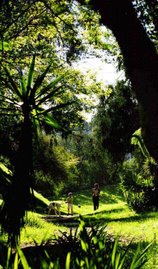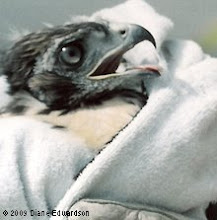Photo: Diane Edwardson, October 12, 2016. All of the Coast Live Oaks on the south end of the Red Car Property are recovering from the fire earlier this summer. All are showing new growth despite the canopy of dry leaves. (Click on photos to enlarge.)
In the weeks immediately after the June 19, 2016, Silver Lake Fire, neighbors watched nervously as trees that did not burn in the fire, rapidly turned brown, but did not drop their leaves, including the protected native Coast Live Oaks and Black Walnuts.
Photo: Diane Edwardson, October 9, 2016. From a distance, the trees look dry, but if you look closely, all have new growth. It's best to walk up and under them to really see how hardy and how large these trees are.
Back in July, I "asked an oak expert" via University of California's Oak Planner's portal. I included photos of the trees and I received a quick response from Gregory A. Giusti, U.C. Agricultural and Natural Resources Cooperative Extension Director for Lake/Mendocino Counties,
"Though they did not burn (flames in the canopy) it appears from your pictures that they were exposed to “heat”. It’s quite possible that the intensity of the fire created enough heat to literally cook the cambial layer on these trees….or at least the branches and twigs. I suspect the live oaks will sprout, if they haven’t done so already."
Guisti and several Black Walnut experts concurred that property owner(s) with fire damaged trees (in the Very High Fire Hazard Severity Zone) should consult LAFD for brush clearance guidelines and that trimming back the dry branches and leaves was ok to reduce the further risk of fire. However, it is best to consult a licensed arborist.
skip to main |
skip to sidebar

Photo: Diane Edwardson

Photo: Edwardson

Photo: Kleven, 1960.
The Corralitas Red Car Property was a private right-of-way through Silver Lake (Los Angeles) for the Pacific Electric interurban streetcar. The “Big Red Cars” ran until 1955 when the Glendale Line was decommissioned for freeway construction. For more than 40 years, a series of developers tried and failed to develop the Corralitas Red Car Property.
It's not a park, it just looks like one.

Photo: Diane Edwardson
Red Car Property Highlights
- Bobcat Sightings
- Legacy of Failed Development
- Red Car Property Development History
- Map
- Silver Lake's Stonehenge
- 2 Freeway History
- 2 Freeway Sound Walls
- 2 Freeway Terminus Project
- Semi-Tropic Spiritualists' Tract
- Public Staircases
- LA River
- Menlo Property
- Metrolink Rail Yard Pollution
- Monte Sano
- Mudwatch
- Neighborhood Native Plants
- Non-Native Plants
- Neighborhood Wildlife
- Red Tailed Hawk Nest Videos
- Ugly Rooftop Watch
- Corralitas Pits of Doom
Historic Neighborhood Photos
- 1904 - 2015 Historic Fletcher Viaduct
- 1904 Curve North of India St.
- 1905 Red Car Property Forest
- 1922 Hunter Terrace - Elysian Gardens Real Estate Brochure
- 1923 - 1962 Holyland Exhibition Collection
- 1923 Allesandro Ave.
- 1927, 1960, 2001 Riverside & Fletcher
- 1930 Lake View Ave.
- 1934 Earl Street Staircase
- 1937 Melton's Market
- 1938-2008 View from atop Corralitas Drive
- 1950 Snow in Silver Lake
- 1953 - 1987 Clarence Inman Collection
- 1960 Corralitas Drive
- 1960 Grass Fire
- 1960 Semi-Tropic Spiritualists' Tract
- 1962 The 2 Freeway Opens
- Paul Landacre Cabin, Historic Landmark

Photo: Edwardson
Neighborhood Wildlife Photos & Highlights
- All Wildlife Posts
- Alligator Lizard
- Birds
- Black Witch Moth
- Bobcat
- Bugs
- Butterflies
- Cooper's Hawk
- Coyotes
- Fox
- Gopher Snake
- Great Blue Heron
- Hawks
- Hummingbirds
- Jerusalem Cricket
- Kestrel
- Moles
- Opossum
- Owls
- Praying Mantis
- Raccoon
- Red Shouldered Hawk
- Reptiles
- Ring-Necked Snake
- Rodents
- Skunks
- Slender Salamanders
- Snake vs Hawk
- Snakes
- Turkey Vulture
- Unusual Bugs
- White-Lined Sphinx Moth

Photo: Kleven, 1960.
Search by Street
Blog Archive
Who we are
- Corralitas Red Car Property
- Community Residents’ Association for Parks is a 501(c)(3) non-profit organization formed in 1997 by our Silver Lake neighborhood. We are dedicated to acquisition and preservation of the Corralitas Red Car Property as a park in partnership with the Santa Monica Mountains Conservancy. Contact: redcarproperty@gmail.com
Links
- Atwater Village Newbie's Red Car Project
- Backwards Beekeepers
- Big Parade LA
- City of Los Angeles 311 Smartphone App
- Electric Railway Historical Association
- LAFD Red Flag Alerts
- Living with Wildlife
- MTA State Route 2 Freeway Terminus Project
- North East Trees
- Northeast LA Residents For Clean Air Coalition
- Pacific Electric Railway Historical Society
- Red Car Trolley Glendale Line
- Semi-Tropic Spiritualists' Tract
- Silver Lake Improvement Association
- Silver Lake Neighborhood Council
- Silver Lake Reservoirs Conservancy
- Silver Lake Residents Association
- The Eastsider LA
- The River Project
- Trust for Public Land
- What's That Bug?
- [sic]
Contact: redcarproperty@gmail.com
Community Residents’ Association for Parks is a 501(c)(3) non-profit organization formed in 1997 by our Silver Lake neighborhood. We are dedicated to acquisition and preservation of the Corralitas Red Car Property as a park in partnership with the Santa Monica Mountains Conservancy.
© 2007 - 2025 Community Residents’ Association for Parks

